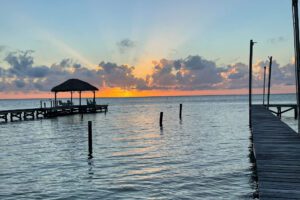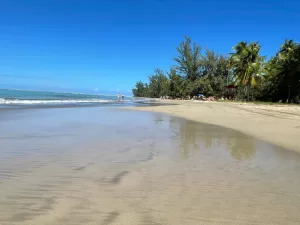Are you thinking about a trip to the Caribbean? Is St. John on your list of potential destinations? Well then, this post is for you. Keep reading and we’ll tell you what to expect from a St. John vacation. First, how to get there (Spoiler, it’s complicated). Second, how long to stay. And lastly, what to do. There are so many fun things to do in St. John, but a St. John vacation isn’t for everyone. Is it right for you? Keep reading to find out.
St. John has a lot going for it. First, the white sand beaches!!!! Second, the white sand beaches!!! And third, the white sand beaches!! Beyond the white sand beaches is the pure wilderness covering most of the island – since 60% of the island is a National Park. Additionally, while St. John has a high price tag – more on that later – almost every thing to do on St. John is free. However, all of this comes with that aforementioned high price tag, which can be a deterrent for some. Additionally, getting to St. John is a multi-step and sometimes multi-day process. So if you’re imagining an easy and relaxing all-inclusive vacation, St. John probably isn’t the best spot for you. However, if you’re interested in a quiet laid back vacation in the secluded wilderness of the tropics, St. John may be one of the best vacation destinations out there.

Stuff In This Post
ToggleWhen Is The Best Time To Visit St. John?
St. John has relatively consistent temperatures throughout the year. Temperatures range from 70-90° F.
January-March is the high season. With temperatures in the low 80s most days. This is also the dry season which means rain will be less likely. However, during the winter months, storms north of the island will cause high waves on beaches for days. This can lead to some beaches being closed, like the famous Trunk Bay. We visited at the end of December and our weather was delightful but we did encounter beach closures one day due to high surf.
Spring is also a good time to visit St. John. Temperatures, humidity and rain chances increase. However, crowds and prices decrease as do the chances of beach closures due to rain.
Summer and Fall are still nice times to visit but hurricane season starts in July and continues through November, with August-September being the most likely hurricane months. However, if you’re willing to have your trip get cancelled, you can find steals and deals during this season. Additionally, if you do visit in these months, even if you don’t get a hurricane, the rain is frequent and longer in duration during these months.
For those who haven’t visited a tropical climate before, keep in mind that it rains year round in the tropics. Everything stated above is relative to the weather of the tropics. We visited in the dry season and had daily rain, though it only lasted for 15-ish minutes. We’ve visited the tropics in the wet season and it rains every hour for 15-ish minutes. That’s the relative scale we’re working with here.

Getting There and Around
How To Get To St. John?
There is no easy way to get to St. John. Which is probably why it still has such pristine and raw beaches and such a rugged vibe.
First, you fly into St. Thomas, the closest island with an airport. You’ll land in Charlotte Amalie. Flights into this island are likely multi-leg journeys (unless you’re coming from a U.S. airport hub). Lots of airlines don’t fly direct to St. Thomas and those that do typically only do in during the peak tourist season.
Next, you’ll need to take a taxi from the airport to Red Hook, which is on the opposite side of St. Thomas from the airport. Don’t worry though, this is only a 45 minute-ish ride and prices are fixed at $17/person. (Time is very loosey goosey in the Caribbean)
Next, you’ll catch a ferry from Red Hook, St. Thomas, to Cruz Bay, St. John. These ferries depart every hour and cost $8.15/person. You’ll have no trouble catching one as they are frequent and the ride is quick.
PS: There is a ferry from St. Thomas, closer to the airport. However, it doesn’t operate as frequently. So this can be a good option depending on when your flight arrives.
Oof, that was a journey. However, it was totally easy to do and everyone on St. Thomas and St. John seems to have an uncanny understanding of how to do it and they are more than happy to help you navigate the multiple connections.

How To Get Around St. John
To get around St. John you’ll need to rent a car or take a cool safari taxi to the many things to see in St. John. Taxis on the island operate more like buses and look more like trucks with seats in the bed of the truck – but those taxi drivers operate more like tour guides, stopping to give you a history of the island if you ask.
We rented a car but definitely benefited from the expertise of the taxi drivers when we stopped to eaves drop on their speeches. Rental cars on the island are all 4WD large vehicles to help you navigate the steep and sometimes rough roads. Rental car prices range from $100-150/day. All rental car companies are local businesses, there are no chain rental companies (Enterprise, Hertz, etc.) on the island.

Driving On St. John
Cars on St. John are imported from America, meaning the steering wheel is on the left. However, driving has British roots, meaning you drive on the left. It is very confusing but our rental car helpfully had a window decal reminding us of this.
There is not a single stretch of straight road on all of St. John. The roads are constantly twisting and turning. For context, the speed limit is 30 mph. Good luck getting to 30 mph. I think I hit 30 twice in our time there.
What makes these twists and turns more challenging than normal is the lack of center lines and very narrow roads. Also everyone seems to drive in the middle of the road until they come across another car which is a bit unnerving around corners.
Additionally, roads are very steep. There are a few turns on the island where the roads are so steep that our 4WD jeep was spinning its tires. And for some reason all of these steep sections also seemed to be on hairpin turns.
So I’ve just highlighted all of the terrifying things about driving on St. John. However, it is totally easy to do. There are few roads, minimal traffic and most people drive slow. So while the actual roads are nerve racking, driving is not impossible. However, if you are going with multiple people, make sure your driver has nerves of steel, is not afraid of heights and avoid driving at night.
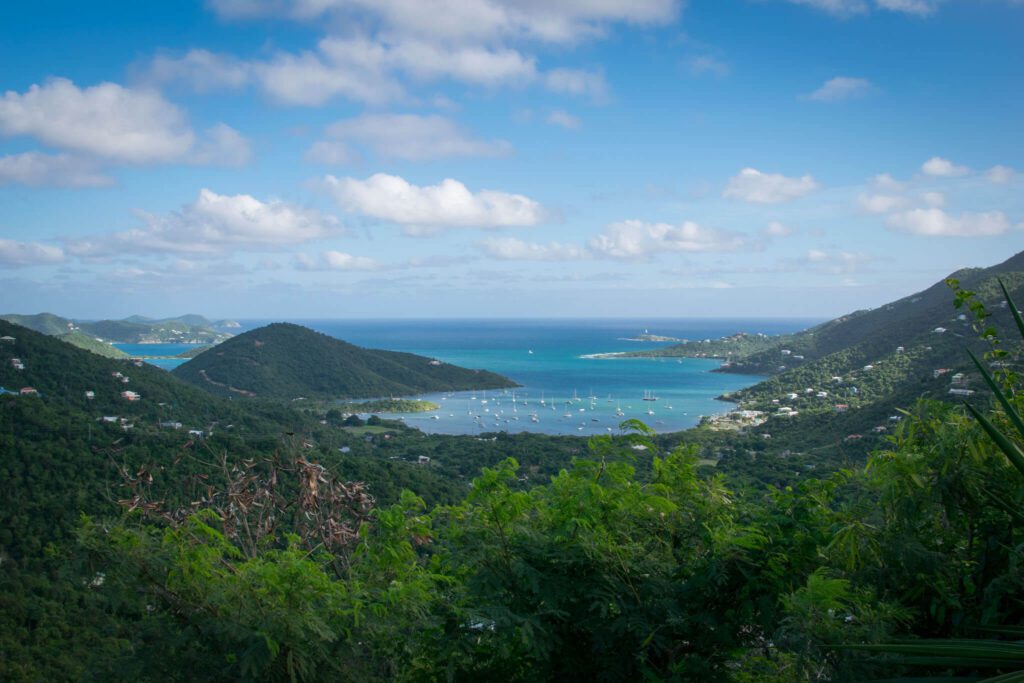
How Long Does It Take To Drive Around St. John?
You can drive around the entire island in under 3 hours. However, if you want to take the scenic route around the island, stopping at scenic viewpoints and doing a tiny bit of exploring, you’ll need a full 8 hours day.
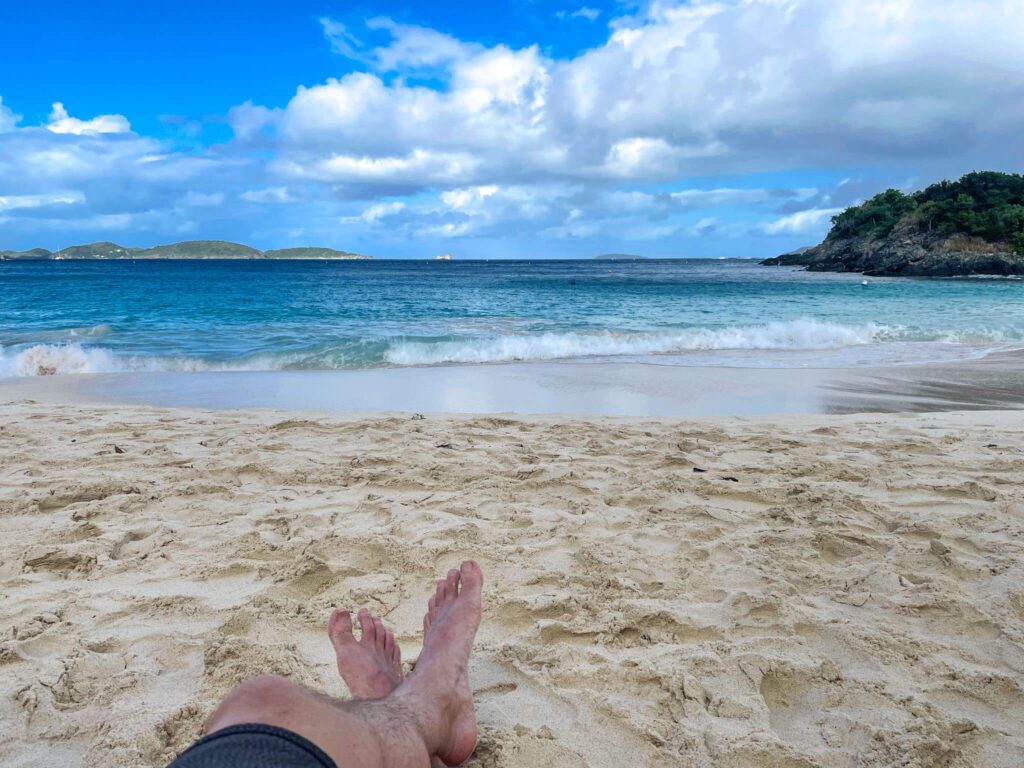
Top Things To Do In St. John
Visit The Beaches
The beaches on St. John are fantastic. The waters are multiple shades of blue and the sand is white and fine. What more could you want in a beach? Each beach is great in its own way, from snorkeling to partying to relaxing, there is a beach for every activity on St. John.

Hike In Virgin Islands National Park
St. John is such a great place to visit because a majority of the island, about 60%, is Virgin Islands National Park. This publicly designated land means that the island remains less inhabited than other islands in the Caribbean. But it also means that the land is available for all to use. So hiking trails through the hills and along the beaches are common. For this reason, it is one of the best places to hike in the Caribbean.
There are some short hikes that lead to amazing beaches, like Waterlemon Bay. And then there are longer hikes that lead to beaches, like the Reef Bay Trail which also takes you to some great viewpoints and petroglyphs. Then there is our favorite hike to Ram Head which takes you from a beach to a great viewpoint. The best part of hiking on St. John? They all either start or end at a beach!
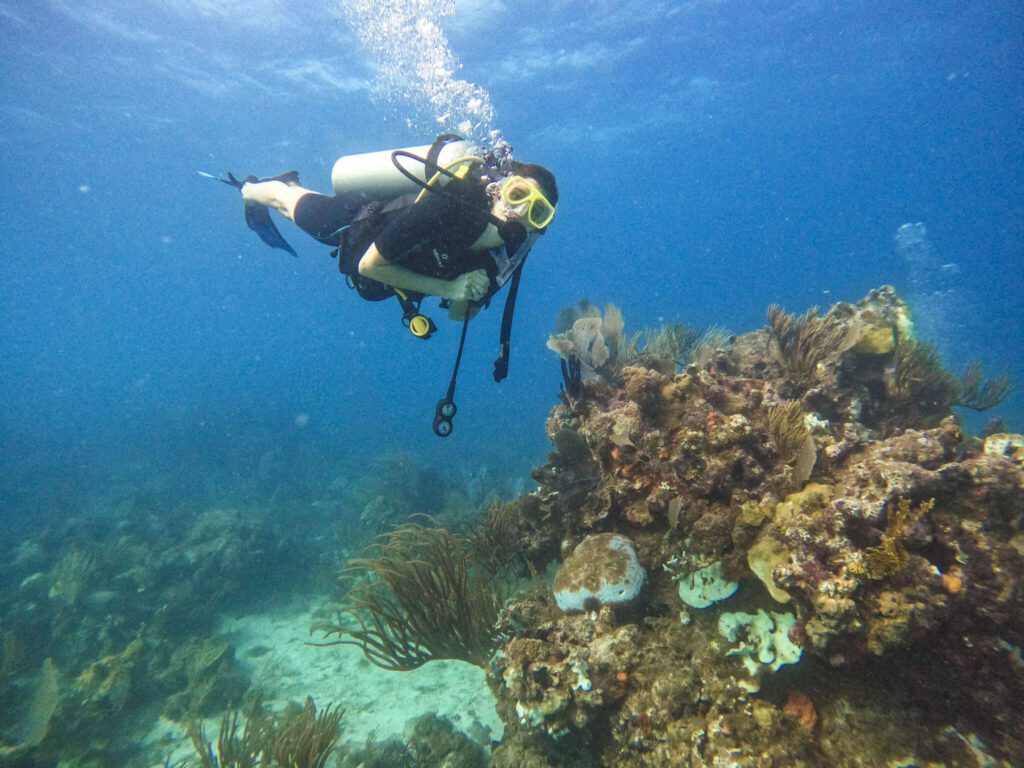
Go Snorkeling
There are so many protected reef inhabited areas around St. John. Which means that the reefs here are some of the healthiest in the Caribbean. And the snorkeling shows it. We’ve never seen such a healthy and diverse shallow water reef as we did at Waterlemon Bay. For our list of recommendations for snorkeling, click here.
If you bring your own snorkeling gear, you can have a low cost activity on pretty much any beach.
However, if you’d prefer to do a snorkeling tour, you can take a half day tour. These generally go to two locations and cost around $130. Full day tours, generally include a more leisurely boat ride to some secluded spot and cost around $200.
Additionally, you could also choose to go scuba diving. Again, the reefs are very healthy and colorful. Most of the dives are shallower than other locations we’ve been. Two tank dives cost around $120/person. And while the scuba diving was great, the snorkeling was equally as great so we’d recommend snorkeling purely for saving some money.

Visit Ruins
St. John was a large producer of sugar and molasses back in the early 1800s. Huge plantations were built to accommodate this bustling industry. Today, there are several areas of the island where you can see ruins of sugar factories and once-large houses, mills and more. At all of the ruins, you can learn about the history of the industry, including the slave trade that drove it.
You can still visit St. John with just one day if you are visiting from St. Thomas. Lots of people do this. However, we’d recommend doing this with a tour as the one day tours are generally really helpful navigating the multiple modes of transportation needed to get here.
If you want to visit with a tour, consider this one here. By booking through our website we’ll earn a commission to help keep this blog running at no extra cost to you.

How Much Does A Trip To St. John Cost?
St. John is expensive. There is no way to get around that. Our 4 day trip for the two of us cost $3920 USD. This equates to about $980/day, which is the MOST expensive vacation we have ever taken. It was a great vacation but it is on the splurge side of things and there isn’t a way to get this down to a budget level. Let’s break it down below.
Here is the breakdown with details below:
- Accommodations – $1370
- Transportation – $1550, including airfare
- Food – $660
- Activities – $340
What To Pack For St. John?
Just imagine how you have always wanted to dress in the Caribbean and then do that. There is no dress code at all. People wear everything from swimsuits with coverups to fancy dresses in town. Also there is virtually no makeup or hair dos in sight. It’s kinda my dream. So what do you need to pack for St. John? Here is our list for 3 days.
For women:
- 3 swimsuits
- 1 coverup
- 1 dress
- 1 pair of shorts
- 1 pair of leggings
- 1 athletic shirt
- 2 casual shirts
- lots of underwear (I wore like 2 each day since I was always swimming or showering mid-day and like a fresh pair)
- 1 sports bra
- 1 regular bra
For men:
- 2 pairs of shorts
- 2 casual shirts
- 1 athletic shirt
- 1 button up shirt
- 1 rash guard
- 2 swimsuits
- lots of underwear (see above)
With the high price of accommodations, they thankfully come with toiletries so don’t plan on packing those. Also, don’t pack makeup or hair styling stuff as you’ll be swimming constantly so you’ll just waste product and time. However, you should pack reef safe sunscreen. It is illegal to use sunscreen with any of the three Os (Oxybenzone, octocrylene and octinoxate) in it. Also, you are not allowed to wear sprayable sunscreen, as it ends up in the ocean more than on your body.
Lastly, make sure to pack your own snorkeling gear. Here is a good travel set. Packing this may take up a bit of room in your suitcase but it will save you money overall.

Is St. John Safe?
St. John is a relatively safe island, the small size makes it a less attractive mark for thieves. Most theft occurs in beach parking lots. So just make sure to lock your car and keep valuables with you or at home.
Cell Service on the island was really good. We did have a few spots where we lost signal, generally in low lying valleys. Additionally, we have a U.S. based cell plan and we did pick up towers from the British Virgin Islands a few times. Once when we were at Leinster Bay and Once when we hiked to Ram Head. So if you are worried about international charges, turn your phones to airplane mode to avoid this.
Most beaches on St. John do not have lifeguards. Be wary of high surf conditions that can create rip currents. A good general practice is to only swim where you see others swimming.
I hope this guide to St. John has helped you to plan your own St. John vacation. If you’re looking for other U.S. Virgin Islands posts, check out our full page here with all of our information in one place. Is St. John not the destination for you? Instead check out other Caribbean destinations here to find the perfect tropical getaway.



